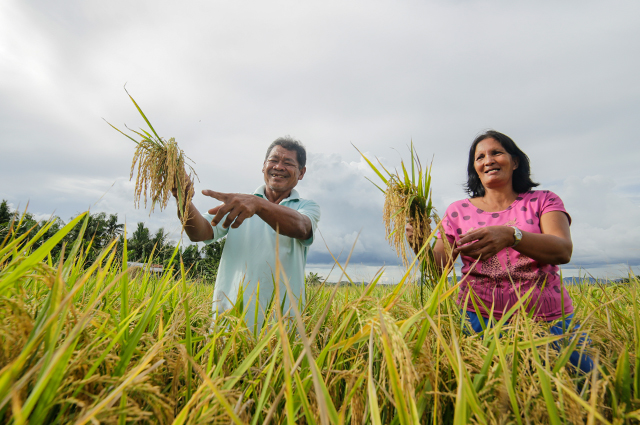Swapping varieties is a common practice among rice farmers in Anilao, Iloilo. Every time farmers would hear of a neighbor’s good yield, they would excitedly ask for some seeds to try hoping that they could also enjoy a handsome harvest.
Edgar Belago, 61, used to cling to this practice.
For more than a decade now, Edgar and his family had been renting and tending a one-hectare farm beside their house where they either plant rice varieties traded from their neighbor, or the seeds from their previous harvest.
Despite their efforts to improve their harvest, Edgar only got 35-45 sacks every cropping period. It was never enough to pay for their debts and expenses. Every season, harvest had always been disheartening for the family.
“The plants look healthy and well when it is raining, but they wilt when it is sunny,” Edgar narrates. “Saltlike, whitish granules settle on top of the soil, and rust is present underneath the soil,” Maria Ana, Edgar’s wife, adds.
The couple also observed some dark spots in the rice grains, or worse, their crops dried up and died. They always believed that the soil was acidic.
Edgar tried growing vegetables on strategic areas in their rice field, but it was not as fruitful as he thought it would be.
Despite all these challenges, Edgar and his family continue and hope that their seemingly unending woe would end soon. “We have to keep on farming because we have needs to attend to,” Maria Ana sighs.
Saline soils
The Belago’s farm and residence is close to the beach. It is perceived that the proximity of the beach to the farm contributes to the salinity of Edgar’s farm. Every time the beachwater reaches the land, salt particles deposit on the soil and stay there when the weather is hot.
Their source of irrigation could not wash the salt sediments away because they only use shallow tube well and they think that the water pump absorbs some of the water from the beach. Sometimes, when the wind sweeps on the land, salt particles are blown away and rest on top of the crops’ leaves.
“Our recent research results revealed that Edgar’s farm soil reached 3.4 – 5.4 dS/m salinity level. This establishes that their farm is among those moderately saline environment,” said Virginia Agreda, head of the Western Visayas Integrated Agricultural Research Center (WESVIARC) in Iloilo City.
According to PhilRice experts, warm weather worsens salt concentration in the soil, which affects plant growth that usually results in reduced rice yield.
Standing tall with Next-Gen
In 2014, WESVIARC, together with PhilRice and IRRI introduced a number of rice varieties that can thrive in the saline soils of West Visayas provinces, including Iloilo. Studies have proven that suitable rice varieties have the mechanism to adapt to biotic and abiotic stresses.
This is part of the Participatory Variety Trial Selection (PVS) of the collaborative project, Accelerating the development and adoption of next-generation rice varieties for major ecosystems in the Philippines, known as Next-Gen. Researchers in this project aimed to identify location-specific varieties and introduce them to rice farmers for increased adoption. The Next-Gen inbred and hybrid rice varieties are resistant to major pests and diseases, and are tolerant to adverse environments for better yields.
“Through the PVS, farmers can test for themselves how these improved varieties perform in their area. Ultimately, appropriate rice varieties become accessible for farmers’ use,” PhilRice expert Thelma Padolina says.
The Belago couple have tried planting NSIC Rc 392 and Rc 480 on their farm. They did not wait too long because results have been obvious owing to their increased harvest.
“Our crops still contest with the warm weather but unlike before, they do not dry up and die anymore. The truth is, we are pleased by the number of sacks that we have to count every harvest season. We could now get at least 90-120 sacks at 42kg per cropping,” Maria Ana delightfully shares.
Edgar said he felt like he had surpassed the test that took him for a long time. For him, it was a blessing to have been introduced to the varieties (Rc 392 and Rc 480).
The Belago couple are living testimonies and credible sources of information for their neighboring farmers about the technology. “Things have been better now,” Edgar humbly describes.
Today, the Belago couple do not need to depend on neighbors’ recommendations on what rice varieties to grow. The Next-Gen Project allows them to identify high-quality rice varieties suitable for their area.





